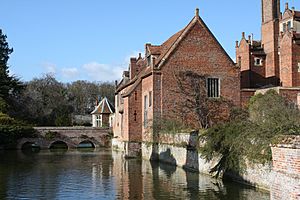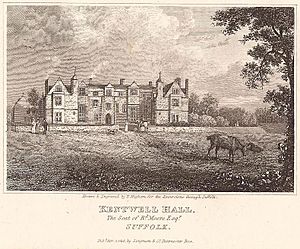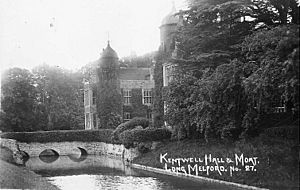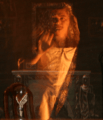Kentwell Hall facts for kids
Quick facts for kids Kentwell Hall |
|
|---|---|
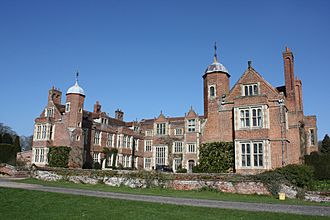
South facade of Kentwell Hall
|
|
| General information | |
| Architectural style | English perpendicular |
| Location | Long Melford, Suffolk, England |
| Coordinates | 52°05′54″N 0°43′07″E / 52.098306°N 0.718516°E |
| Construction started | 15th century |
Kentwell Hall is a beautiful old country house in Long Melford, Suffolk, England. It's not just a house; it also has other buildings, a farm with rare animals, and lovely gardens. Most of the house you see today was built in the mid-1500s. But Kentwell's story goes back much further, even to the Domesday Book in 1086.
This historic hall has been used as a setting for many movies and TV shows. Since 1979, it has also hosted amazing Tudor period historical re-enactments every year. People also hold weddings and other special events here.
The History of Kentwell Hall
Kentwell's Early Days
The first time Kentwell is mentioned in history is in the Domesday Book from 1086. This old book says that the land of Kentwell belonged to a man named Frodo. He was the brother of Abbot Baldwin from the Abbey of St. Edmund's.
Back then, the area was known by its old English name, Kanewella. The Domesday Book describes it as a manor with land, villagers, animals, and meadows. It was worth 40 shillings then, but later became worth £4.
For about 300 years after that, we don't know much about Kentwell's owners. Some old church papers mention a "De Kentewell" family in the 1200s.
Later, between 1252 and 1272, King Henry III gave Kentwell Manor to Sir William de Valence. After he died in battle, Kentwell went to his niece. She married David Strabolgie, who was the Earl of Athol. In 1333, he passed the manor to Sir Robert Gower. Later, in 1368, it went to John Gower, a famous poet and friend of Geoffrey Chaucer.
In 1373, Sir John Cobham bought Kentwell. Soon after, it became owned by the Mylde family.
The Clopton Family at Kentwell
The Clopton family took over Kentwell Hall around 1375. This happened when Sir Thomas Clopton married Katherine Mylde, whose family owned the estate. The Cloptons were an important local family. Some of them even became famous across England in the 1400s and 1500s.
The Clopton family changed the manor into the house we recognize today. They lived at Kentwell until 1661. Before the current house, there was an older manor house called Lutons. It was located about a quarter-mile north-west of where Kentwell Hall stands now. Old maps even show a small chapel of Saint Anne near the old house.
The current Kentwell Hall was built in stages by different generations of the Clopton family. The oldest part is the Moat House, built in the early 1400s. It has three levels and was used for things like a dairy, bakery, and brewery. Historians think the Moat House might have been the main home before the larger hall was built.
We don't know for sure who built the Moat House. Many historians believe it was Sir William Clopton. He fought in the Battle of Agincourt in 1415. He is buried in the nearby Holy Trinity Church, where you can see his statue in armor.
The main part of Kentwell Hall was built in three steps. John Clopton started the main block in the late 1400s. His grandson, William Clopton, added the wings in the 1540s. Finally, William's son, Francis Clopton, added a third level and a new long gallery in the 1560s.
The Cloptons also helped rebuild the Holy Trinity Church in Long Melford. They added many stained glass windows showing their family. They also built a special chapel in the church just for their family.
Kentwell in the 1600s
By the early 1600s, the Clopton family's power was fading. Kentwell Hall then came under the care of the Waldegrave and Darcy families. Many Cloptons moved to the American colonies. One of them, Thomasine Clopton, married John Winthrop. He helped start the city of Boston and was the first Governor of the Massachusetts Bay Colony.
In 1676, Sir Thomas Darcy sold Kentwell Manor to Thomas Robinson. Robinson was a lawyer who was made a baronet by King Charles II in 1681. He planted the mile-long path of lime trees that leads to the house, which you can still see today. He also made changes inside the house, like building a grand staircase.
Sadly, Robinson died in 1683 trying to escape a fire. Kentwell went to his son, Sir Lumley Robinson, but he died the next year. The third Sir Thomas Robinson sold Kentwell in 1685 to pay off his gambling debts. The new owners were the family of Sir John Moore, who had been the Lord Mayor of London.
From the Late 1600s to Early 1800s
This time period is not very well known in Kentwell's history. The Moore family owned Kentwell, but we don't have many details about what happened then.
From 1782 to 1823, Richard Moore owned the house. He made some changes to the inside. You can still see Georgian style details like fancy fireplaces and doorways from this time. The fireplace in the Moat Bedroom has the Moore family's coat of arms. Some historians think the Library and Billiard Room were also created then.
The Victorian Era at Kentwell
In 1823, Robert Hart Logan bought Kentwell Hall. He was from Canada and had become rich in the timber business.
Just three years later, in 1826, a fire broke out. It destroyed much of the central part of the house, including the dining room. This made Logan decide to make big changes to the house's interior. He hired Thomas Hopper, a famous Victorian architect, to design the new look.
Hopper made the biggest changes to the main dining room and the Great Hall. Logan wanted a mix of old English styles, which you can still see today. In the Great Hall, the old screen and gallery were replaced. The ceiling was rebuilt with a design copied from another house, Audley End. It looks like oak but is actually made of plaster.
The dining room was designed with Tudor arches at the top and Jacobean arches at the bottom. A large, fancy fireplace with the Clopton and Logan family crests dominates the room.
Logan died in 1839, owing money. Kentwell was then sold to the Starkie Bence family. They owned or rented out the house for over a hundred years.
Kentwell in the 1900s and Today
From 1889, the Starkie Bence family rented out Kentwell Hall to many different people. These included famous figures like Sir John Aird and racing driver Dick Seaman. Sir Connop Guthrie's wife even redesigned the gardens.
During World War II, the army took over the house and park. They used it as a large camp for soldiers moving through. British airborne troops and parts of the 50th (Northumbrian) Infantry Division stayed there before D-Day. The owner, Mrs. Maithal Starkie Bence, still lived in some rooms during this time.
The Starkie Bence family finally sold Kentwell in 1971. Today, Patrick and Judith Phillips own Kentwell Hall and live there. Patrick Phillips bought the house when it was in very bad shape. To pay for repairs and restoration, they opened the house to the public.
Fun Events and Historical Re-enactments
Step Back to the Tudor Period
Since 1979, Kentwell Hall has hosted amazing Tudor period re-enactment events. These shows bring to life what daily Tudor life was like. Up to 350 volunteers dress up in costumes each day. These events happen for three weeks in June and July every year, with smaller events at other times.
Each year has a special theme based on a specific year in the Tudor period. Costumes and events are planned to match. Some important Tudor years have been shown many times. These include 1588 (the Spanish Armada), 1535 (the Dissolution of the Monasteries), and 1578 (when Queen Elizabeth I visited Suffolk).
When you visit Kentwell, the people in costumes talk to you like they are really from the 1500s. They describe their lives in the 16th century, making it feel like you've traveled back in time!
Gallery of Tudor Re-enactments
World War II Events
In April 1995, Kentwell Hall held its first World War II re-enactment. This was to celebrate the 50th anniversary of VE Day. The event made Kentwell look and feel like wartime Britain. Volunteers played both soldiers and regular people. Kentwell has continued to host World War II events since then.
Victorian Christmas Fun
Kentwell Hall has also presented Victorian period re-enactment events since 2009. Their special "Dickensian Christmas" events show what a Victorian manor house was like. You can see costumed families and servants. There are readings from A Christmas Carol with an actor playing Charles Dickens. You can also enjoy a Victorian music hall and tearooms.
Scaresville: A Spooky Event
Scaresville is a popular annual Hallowe'en event at Kentwell. It takes place over four weeks in October. This event started in 2007. In 2009, Scaresville was even voted the Best Seasonal or Hallowe'en Event at the UK's Screamie Awards!
Weddings and Other Gatherings
Kentwell Hall is a licensed place for civil wedding ceremonies. It also hosts business events, outdoor plays, and music concerts throughout the year.
Kentwell on Screen: Film and TV Location
Kentwell Hall has been used as a filming location for many movies and TV shows. Here are some of the most famous ones:
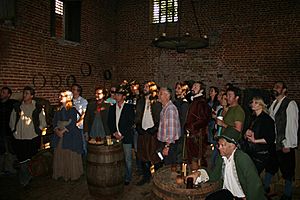
| Year | Title | What Kentwell was used for |
|---|---|---|
| 1968 | Witchfinder General | A horror film starring Vincent Price. |
| 1982 | The Woman In White | A BBC TV show based on a novel. |
| 1982 | The Agatha Christie Hour: In a Glass Darkly | A TV show based on an Agatha Christie short story. |
| 1983 | No Excuses | An ITV TV drama about a rock star. |
| 1988 | Treasure Hunt | A Channel 4 TV game show with Anneka Rice in a helicopter. |
| 1994 | Will's World: A Surfeit of Meate and Drynke | A BBC TV show about William Shakespeare, featuring Kentwell's Tudor cooks. |
| 1996 | The Wind in the Willows | Kentwell was used as the outside of Toad Hall. |
| 2003 | Warrior Women: Grace O'Malley, Pirate Queen | A Discovery Channel show where Kentwell was Greenwich Palace. |
| 2003 | Royal Deaths and Diseases | A Channel 4 show featuring Kentwell re-enactors. |
| 2004 | Days That Shook the World: Affairs of the Crown | A BBC TV show about Anne Boleyn, with Kentwell re-enactors. |
| 2005 | The Gunpowder Plot: Exploding The Legend | An ITV show hosted by Richard Hammond, filmed around Kentwell. |
| 2005 | The Chronicles of Narnia: The Lion, the Witch and the Wardrobe | Kentwell Hall briefly appeared as the outside of the Professor's house. A digital model was made of the house. |
| 2013 | Henry VII: Winter King | A BBC TV show using Kentwell locations and re-enactors. |
| 2014 | Tulip Fever | A movie starring Alicia Vikander and Dame Judi Dench, filmed at Kentwell. |
| 2015 | History's Ultimate Spies | A docudrama about historical spies like Thomas Cromwell, filmed at Kentwell. |
| 2015 | Draw on Sweet Night | An independent film, also filmed at Kentwell. |
Images for kids


